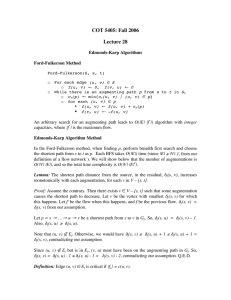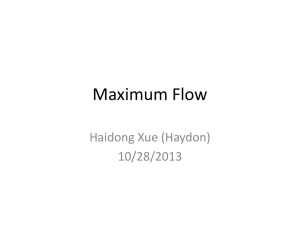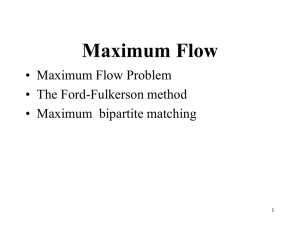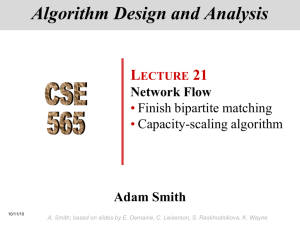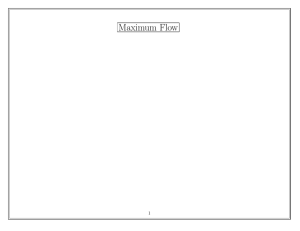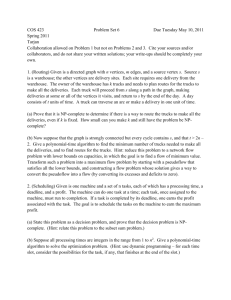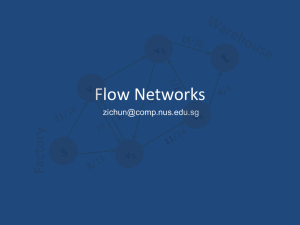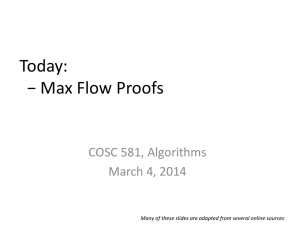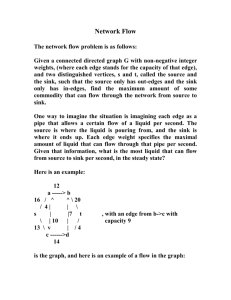Maximum Flow
advertisement
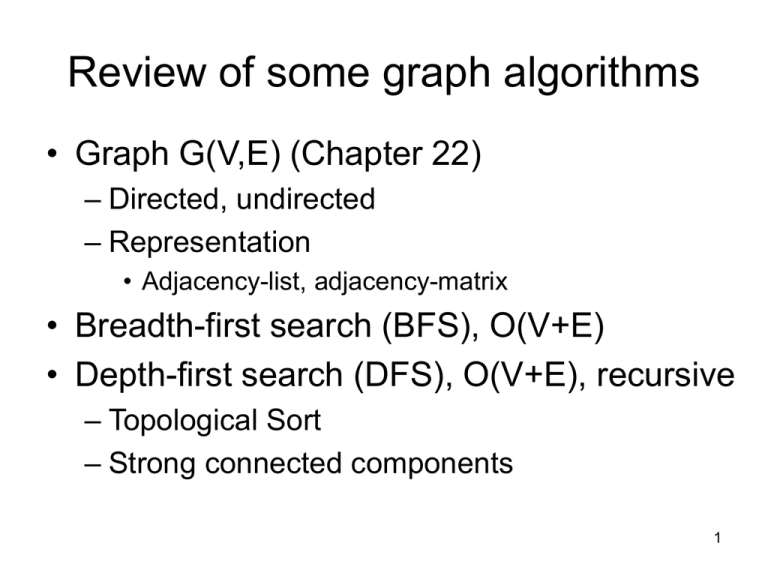
Review of some graph algorithms
• Graph G(V,E) (Chapter 22)
– Directed, undirected
– Representation
• Adjacency-list, adjacency-matrix
• Breadth-first search (BFS), O(V+E)
• Depth-first search (DFS), O(V+E), recursive
– Topological Sort
– Strong connected components
1
Review of some graph algorithms
• Minimum Spanning Tree (Chapter 23)
– Greedy algorithm
– Kruskal’s algorithm: O(ElgV)
• Using disjoint set algorithm, similar to connected components
– Prim’s algorithm: O(E+VlgV)
• Similar to Dijkstra, using min-priority QUEUE
• Single-source shortest paths (Chapter 24)
– Bellman-Ford algorithm: O(VE)
• dj=min{dj,dk+w(j,k)} where k is j’s neighbor
– Dijkstra’s algorithm: O(E+VlgV)
• Find the closest node n1 which is s’s neighbor, modify other nodes distance
• Find the second closest node n2 which is the neighbor of s or n1, modify the
distance
• Find the third closest node n3, which is the neighbor of s, n1, or n2, ,….
2
Graph algorithms (cont.)
• All-pairs shortest paths (Chapter 25)
– Floyd-Warshall algorithms: O(V3).
– Dynamic programming, similar to Matrix
Chain Multiplications
– dij(0)=wij
– For k1 to n
• for i1 to n
– for j1 to n
» dij(k)=min(dij(k-1),dik(k-1)+dkj(k-1))
3
Maximum Flow (chap. 26)
• Max-flow problem:
– A directed graph G=<V,E>, a capacity function on
each edge c(u,v) 0 and a source s and a sink t. A
flow is a function f : VVR that satisfies:
• Capacity constraints: for all u,vV, f(u,v) c(u,v).
• Skew symmetry: for all u,vV, f(u,v)= -f(v,u).
• Flow conservation: for all uV-{s,t}, vV f(u,v)=0, or to say,
total flow out of a vertex other s or t is 0, or to say, how much
comes in, also that much comes out.
– Find a maximum flow from s to t.
– Denote the value of f as |f|=vVf(s,v), i.e., the total
flow out of the source s.
• |f|=uVf(u,t), i.e., the total flow into the sink t.
4
Example of max-flow problem
5
Ford-Fulkerson method
• Contains several algorithms:
– Residue networks
– Augmenting paths
6
Residual Networks
• Given a flow network G=<V,E> and a flow
f,
– the residual network of G induced by f is
Gf=<V,Ef> where Ef={(u,v)VV:
cf(u,v)=c(u,v)-f(u,v), and cf(u,v)>0}
– a network with left capacity >0, also a flow
network.
7
Residual network and augmenting path
8
Residual network and flow theorem
• Lemma 26.2 (page 653):
– Let G=<V,E> be a flow network with source s and sink
t, and let f be a flow,
– Let Gf be the residual network of G induced by f, and
let f' be a flow of Gf.
– Define the flow sum: f+f' as:
– (f+f')(u.v)=f(u.v)+f'(u.v), then
– f+f' is a flow in G with value |f+f'|=|f|+|f'|.
• Proof:
– Capacity constraint, skew symmetry, and flow
conservation and finally |f+f'|=|f|+|f'|.
9
Augmenting paths
• Let G=<V,E> be a flow network with source s and
sink t, and let f be a flow,
• An augmenting path p in G is a simple path from s
to t in Gf, the residual network of G induced by f.
• Each edge (u,v) on an augmenting path admits
some additional positive flow from u to v without
violating the capacity constraint.
• Define residual capacity of p is the maximum
amount we can increase the flow:
– cf(p)=min{cf(u,v): (u,v) is on p.}
10
Augmenting path
• Lemma 26.3 (page 654):
– Let G=<V,E> be a flow network with source s and sink
t, let f be a flow, and let p be an augmenting path in
Gf. Define fp: VVR by:
• fp(u,v)= cf(p) if (u,v) is on p.
•
-cf(p) if (v,u) is on p.
•
0 otherwise
– Then fp is a flow in Gf with value |fp|=cf(p) >0.
• Corollary 26.4 (page 654):
– Define f'=f+fp, then f' is a flow in G with value
|f'|=|f|+|fp|>|f|.
11
Basic Ford-Fulkerson algorithm
Running time: if capacities are in irrational numbers, the algorithm may not terminate.
Otherwise, O(|E||f*|) where f* is the maximum flow found by the algorithm: while loop
runs f* times, increasing f* by one each loop, finding an augmenting path using depth12
first search or breadth-first search costs |E|.
Execution of Ford-Fulkerson
13
An example of loop |f*| times
Note: if finding an augmenting path uses breadth-first search, i.e., each augmenting
path is a shortest path from s to t in the residue network, while loop runs
at most O(|V||E|) times (in fact, each edge can become critical at most |V|/2-1 times),
so the total cost is O(|V||E|2). Called Edmonds-Karp algorithm.
14
Network flows with multiple sources and sinks
• Some problems can be reduced to maximum
flow problem. Here give two examples.
• Reduce to network flow with single source and
single sink
• Introduce a supersource s which is directly
connected to each of the original sources si with
a capacity c(s,si)=
• Introduce a supersink t which is directly
connected from each of the original sinks ti with
a capacity c(si,s)=
15
Maximum bipartite matching
• Matching in a undirected graph G=(V,E)
– A subset of edges ME, such that for all vertices vV,
at most one edge of M is incident on v.
• Maximum matching M
– For any matching M′, |M|| M′|.
• Bipartite: V=LR where L and R are distinct and
all the edges go between L and R.
• Practical application of bipartite matching:
– Matching a set L of machines with a set R of tasks to
be executed simultaneously.
– The edge means that a machine can execute a task.
16
Copyright © The McGraw-Hill Companies, Inc. Permission required for reproduction or display.
17
Finding a maximum bipartite matching
• Construct a flow network G′=(V′,E′,C) from
G=(V,E) as follows where =LR:
– V′=V{s,t}, introducing a source and a sink
– E′={(s,u): uL} E {(v,t): vR}
– For each edge, its capacity is unit 1.
• As a result, the maximum flow in G′ is a
maximum matching in G.
18
Copyright © The McGraw-Hill Companies, Inc. Permission required for reproduction or display.
19
